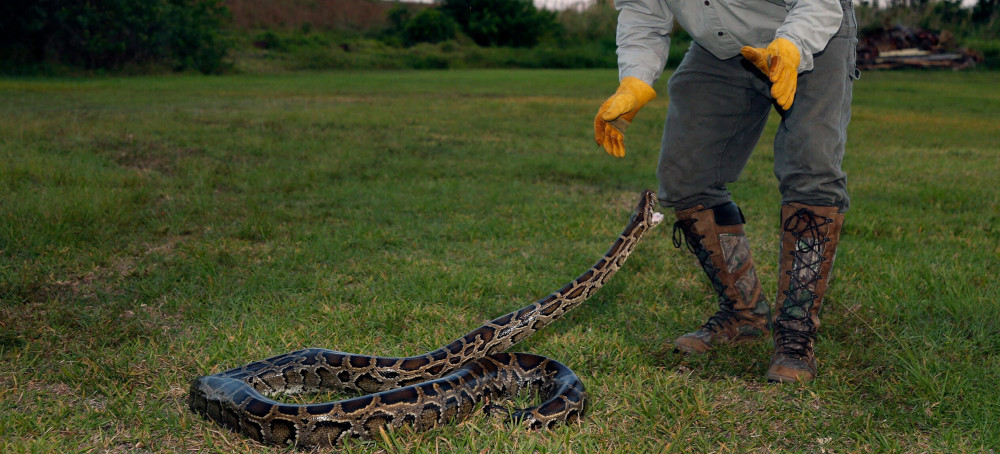Climate Change Is Pushing Animals Closer to Humans, With Potentially Catastrophic Consequences
Kiley Price Inside Climate News Contractors help eradicate Burmese pythons in the Florida Everglades. (photo: AFP)
Contractors help eradicate Burmese pythons in the Florida Everglades. (photo: AFP)
As temperatures warm, some animals are expanding their geographic range—and overlapping with humans.
Today, I’m exploring a few of the recently emerging threats from increasing human interactions with wild animals—and how scientists and governments are trying to mitigate them.
A Spike in Human-Wildlife Conflict: On top of heat waves and rising sea levels, some people in Asia, Sub-Saharan Africa, Australia and Florida may have to worry about an influx of deadly snakes in their region as climate change accelerates.
A recent study found that warming temperatures could expand the geographic range for certain venomous snakes such as the west African gaboon viper and the European asp, primarily in Asia and Sub-Saharan Africa.
While the majority of venomous snake species may lose habitat as climate change continues, some dangerous species could start overlapping with crop fields or livestock areas in low-income countries, according to the study. The World Health Organization has also been tracking this trend, and put out a “call for urgent action” in January asking countries to start preparing for an increased risk of snakebites by stockpiling antivenom and educating people who will be exposed to the lethal reptiles.
Though not pointed out in this study, biologists have already noticed an increase in snake activity in Australia as shortened winters coax snakes out of their period of relative dormancy, known as brumation, earlier each year. That’s meant more business for the snake catchers in the country, The New York Times reports.
“Not only are snakes becoming more active earlier in the year and staying active longer in the year, but it also means that they’re going to stay active longer into the night,” Bryan Fry, a professor of biology at the University of Queensland, told the Times.
In Florida, Burmese pythons are increasingly slithering across the Everglades, after originally being introduced by humans around the 1980s, likely by people who had them as pets, experts say. Now, climate change could be leading them even further northward, according to the U.S. Geological Society. A recent study suggests that pythons could actually become an accessible and climate-friendly alternative to other proteins since they emit much less gas through burps than cows.
These snakes are already a delicacy in Thailand and Vietnam, though some researchers are skeptical that they could ever scale up on North American food markets and warn of high-mercury levels in snakes across Florida, writes Ashley Miznazi for the Miami Herald.
Outside the snake world, the cause of other human-wildlife conflicts can be more complex.
For example, melting sea ice is causing polar bears in the Arctic to spend more time hunting on land—and closer to people. Though no individual polar bear attack can be directly tied to climate change, maulings over the past two decades highlight how shifting habitats can increase the chances of deadly encounters with wild animals, reports the Washington Post.
Countless examples of these climate-influenced interactions between humans and wildlife can be found all over the world, and can harm animals alongside humans. This week, I am writing from Cape Cod, Massachusetts, where I am reporting a story about North Atlantic right whales. In the past, I’ve covered how these ocean giants are moving closer to human activity in shipping lanes as their main food source—tiny crustaceans known as copepods—shifts its range, largely in response to climate change. Vessels can unintentionally collide with and kill the whales, contributing to the worldwide issue of “ocean roadkill.”
Animal-Borne Disease Outbreaks: As we’ve seen with bird flu, animal diseases aren’t always limited to one species. As the impacts of climate change force animals and humans closer together, there are more chances for these disease “spillover events,” reports the Financial Times.
In many cases, the greatest climate-induced spillover risk comes from some of the smallest animals: insects. Warming temperatures can accelerate reproduction, increase biting rates and expand the geographic range of different species of mosquitoes, which carry a variety of diseases. A 2023 report from the World Health Organization highlighted the link between climate change and malaria, which is spread by the Anopheles mosquito.
Similarly, mosquito-borne dengue fever is spreading to places where it had not previously been detected due to climate change and urbanization, reports Sierra Magazine. The situation is particularly bleak in Peru, where dengue deaths have more than tripled so far this year.
“The mosquito has been adapting to climate change and is reproducing at a faster rate than in previous years,” University of Lima epidemiologist Augusto Tarazona told Reuters. “We are in a critical situation in Latin America.”
Scientists are also investigating the nexus of climate change and lyme disease, which is carried by ticks. Research suggests that warmer and more humid conditions are expanding the range of ticks in some areas such as Maine and Wisconsin. To help slow the spread of zoonotic illnesses, countries are ramping up surveillance efforts through the use of community reporting networks and artificial intelligence.



